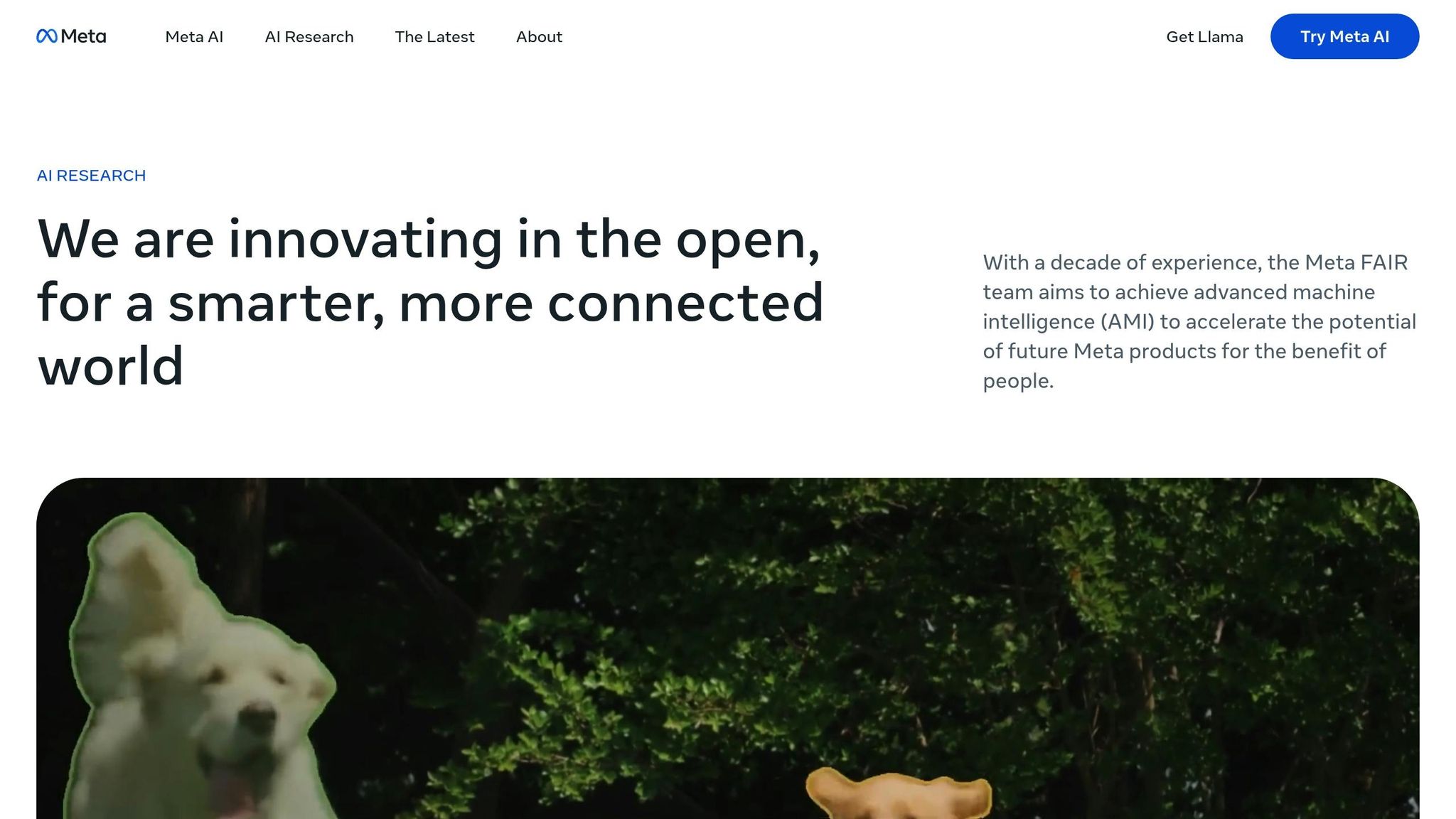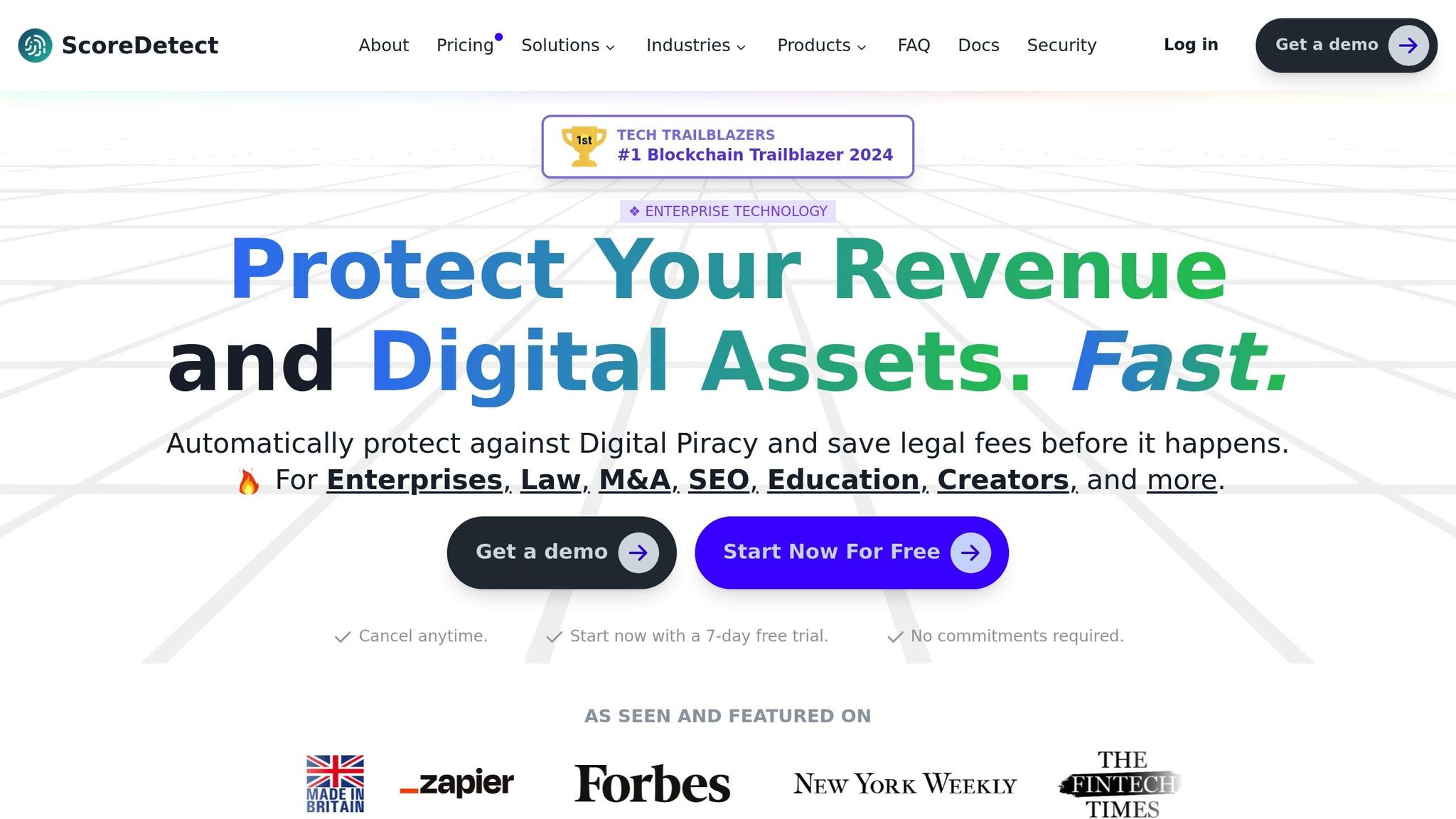AI watermarking is transforming how digital content is protected, offering solutions that are more resilient, efficient, and scalable compared to traditional methods. Traditional techniques, like visible logos or invisible signals added post-production, are vulnerable to edits, compression, and removal. In contrast, AI watermarking embeds protection directly during content creation, making it harder to tamper with while maintaining the content’s quality.
Key Differences:
- Durability: AI watermarks withstand cropping, scaling, and compression better than traditional ones.
- Efficiency: AI automates the process, handling large volumes quickly, unlike manual traditional methods.
- Scalability: AI solutions protect thousands of assets simultaneously, whereas traditional methods struggle with bulk operations.
- Visual Impact: AI watermarks are invisible, preserving the original look, while traditional visible marks can disrupt the content’s appearance.
AI watermarking also integrates advanced detection systems and cryptographic security, ensuring ownership verification remains intact even against modern threats like deepfakes. While traditional methods still serve niche purposes, especially where visible marks are required, AI-powered solutions are redefining protection for industries like media, education, and legal services. Platforms like ScoreDetect exemplify these advancements, combining invisible watermarking, blockchain verification, and automated content monitoring for robust digital asset security.
Watermark Anything with Localized Messages | Dr. Pierre Fernandez, FAIR MetaAI | BLISS e.V.

Traditional Watermarking Methods Overview
Traditional watermarking has been a go-to method for safeguarding digital content. By embedding identifying marks, it helps establish ownership and discourage unauthorized use. Unlike modern AI-driven techniques, these methods are applied after content is created, functioning as a post-production solution rather than a built-in security measure.
How Traditional Watermarking Works
Traditional watermarking operates through two main phases: embedding and verification.
During the embedding phase, a watermark is added to the digital content using specialized tools or manual techniques. The verification phase involves detecting and extracting the watermark to confirm ownership or authenticity.
- Visible watermarks, like logos, text overlays, or transparent images, are directly placed over the content. Stock photo agencies, for instance, often use visible logos to protect their images. While effective in signaling ownership, these marks can disrupt the viewing experience and are easily removed through simple edits like cropping.
- Invisible watermarks are more subtle. They are embedded by altering pixel values or frequency components in a way that doesn’t visibly affect the content. Techniques like the Discrete Cosine Transform (DCT) or Discrete Wavelet Transform (DWT) are commonly used to embed watermarks into the frequency domain, making them harder to notice while still detectable with specialized tools.
For example, a photographer might use spatial domain techniques to tweak pixel values directly, while frequency domain methods allow the watermark to endure transformations like compression or resizing. However, verifying invisible watermarks often requires complex algorithms or manual effort, which can be a bottleneck when dealing with large quantities of media.
Problems and Limitations
Despite their utility, traditional watermarking methods face several challenges:
- Vulnerability to Removal: Since watermarks are applied after content creation, they’re inherently at risk. Visible watermarks can be cropped or edited out, while invisible ones may degrade during compression or other modifications.
- Geometric Attacks: Simple edits like cropping, rotation, or scaling can distort or weaken embedded watermarks. Research by Duan et al. points out that post-production watermarking lacks alignment with the content’s semantics, making it more susceptible to such attacks.
- Lack of Automation and Scalability: For media companies managing thousands of images or videos, manual watermarking is slow and prone to errors. This limitation makes traditional methods unsuitable for real-time or large-scale operations.
- Quality Trade-offs: Visible watermarks can obscure important parts of an image or video, while invisible ones must balance being robust enough to survive edits without compromising the content’s quality.
- Interoperability Issues: The absence of standardization across tools complicates cross-platform use. A watermark embedded with one proprietary system might not be readable by another, creating a fragmented ecosystem that slows the development of universal solutions.
These challenges highlight the need for more integrated and efficient content protection methods, setting the stage for newer approaches that embed security directly into the creation process.
AI-Powered Watermarking Developments
Artificial intelligence is reshaping watermarking by addressing the shortcomings of traditional methods. Instead of adding a watermark after content is created, AI integrates protection right at the creation stage. This approach not only embeds security from the start but also simplifies later detection and analysis, creating a smoother and more effective way to safeguard digital content.
How AI Watermarking Works
AI-driven watermarking uses three main approaches: embedding watermarks during content generation, making adjustments after creation, and incorporating modifications into training data. These methods ensure the watermark aligns seamlessly with the content’s structure and meaning [1][2].
Among these, in-generation watermarking marks a major step forward. By embedding the watermark directly during the content synthesis process, it uses the model’s internal features to align the watermark with the content’s semantics. This is a significant improvement over older methods, which often applied watermarks without considering the actual content [2].
To enhance security, many systems employ cryptographic techniques to embed a secret key. This ensures that detecting or verifying the watermark is only possible with proper authorization [3][5].
AI watermarking adapts to various content types with tailored techniques. For text, it might involve subtle linguistic tweaks; for images, pixel or color adjustments; for audio, slight frequency shifts; and for video, frame-based modifications. Detection systems then analyze the content for patterns or statistical anomalies, using similarity scores calibrated to minimize false positives [2][3].
Key Benefits of AI Watermarking
AI watermarking offers several advantages over traditional methods. A key strength is its resilience to attacks. By embedding the watermark within the content’s core structure, it can better withstand alterations like cropping, scaling, rotation, or compression – issues that often compromise traditional watermarks [1][2].
Another benefit is speed and scalability. AI watermarking systems can protect large volumes of content in real time. For instance, Google DeepMind’s SynthID provides a practical solution for text watermarking, offering high detection accuracy with minimal delays [3].
One standout feature is the invisibility of AI watermarks. Unlike traditional visible overlays, these watermarks protect content without affecting its appearance or meaning [2][3]. Advanced detection methods, often powered by deep learning, can identify watermarks even after content has been degraded or transformed. These algorithms are trained to handle various degradation scenarios, ensuring consistent detection [4].
AI watermarking also integrates effortlessly with digital workflows. For example, ScoreDetect uses advanced AI to embed invisible watermarks, preventing unauthorized use while streamlining content management [3].
Finally, cryptographic techniques add an extra layer of security. Only authorized parties can verify the watermark, protecting it from unauthorized detection or tampering. This makes AI watermarking especially valuable in scenarios where maintaining content integrity and confidentiality is essential [3].
AI vs Traditional Watermarking Comparison
When evaluating performance metrics like robustness, speed, and scalability, AI-powered watermarking clearly outshines traditional methods in many ways.
Comparison Table
Here’s a side-by-side look at how AI-based watermarking stacks up against traditional approaches on key attributes that matter to content creators and businesses:
| Attribute | Traditional Methods | AI-Powered Methods |
|---|---|---|
| Robustness | Vulnerable to cropping, compression, editing, and format conversion. | Highly resistant to tampering, including geometric attacks. |
| Speed | Relies on manual, sequential processing. | Automated and fast, enabling real-time operations. |
| Scalability | Limited to small batches and often needs human oversight. | Handles thousands of assets simultaneously with ease. |
| Ease of Use | Requires technical knowledge and manual effort. | User-friendly with automated workflows. |
| Visual Quality | May leave visible artifacts that degrade content. | Preserves original appearance with imperceptible watermarks. |
| Detection Accuracy | Accuracy drops significantly after modifications. | Maintains high accuracy even after moderate content alterations. |
AI watermarking goes a step further by embedding protection directly into the content during its generation. This deep integration makes removal nearly impossible without access to the original model or cryptographic key, offering a level of security that traditional methods simply can’t match.
Best Use Cases for Each Method
The choice between traditional and AI-powered watermarking often depends on the type of content, the level of security required, and the operational scale.
Traditional Watermarking
While limited in many aspects, traditional methods still have their place. For example, stock photography platforms commonly use visible watermarks on preview images to ensure clear attribution. Similarly, legacy systems or situations where visible ownership marks are legally mandated may benefit from traditional approaches.
AI-Powered Watermarking
AI watermarking shines in high-security and large-scale environments. Media companies protecting valuable video content, educational institutions safeguarding research materials, and digital businesses managing extensive asset libraries are all prime candidates for AI solutions.
This technology is particularly effective in high-volume workflows. Tools like ScoreDetect showcase this by embedding invisible watermarks across a wide range of digital assets in real time. AI methods are also adaptable to different media formats – whether it’s text, images, audio, or video – using specialized algorithms designed for each type. Traditional methods, by contrast, often require separate tools for different formats, adding complexity to the process.
Industries that prioritize seamless integration into workflows also find AI watermarking invaluable. For instance, marketing agencies, content creators, and digital businesses can incorporate protection directly into their content creation processes without interruptions. Beyond this, features like blockchain integration – offered by platforms like ScoreDetect – provide verifiable proof of ownership, a capability that traditional methods lack entirely.
Cost Considerations
While AI watermarking may require a higher upfront investment, its operational efficiency and superior protection often make it a cost-effective choice for organizations managing valuable or high-volume digital content. Over time, the benefits of scalability and resilience can far outweigh the initial expense.
sbb-itb-738ac1e
Industry Applications and Use Cases
AI-powered watermarking has become a go-to solution for securing digital assets across various industries. Each sector adapts these technologies to meet its specific needs, leveraging the strengths of AI watermarking to address unique challenges. Let’s explore how different industries are putting this innovation to work.
Copyright Protection Applications
The media and entertainment industry has been at the forefront of adopting advanced watermarking tools. Their primary goal? To combat piracy and track unauthorized content distribution. By embedding ownership details directly into images, videos, and audio files, companies create a digital fingerprint that withstands manipulation. These invisible watermarks are especially useful for streaming platforms and content distributors, as they maintain high visual and audio quality while ensuring robust protection.
Major players in the industry have embraced AI-powered invisible watermarks to verify content origins. This approach not only combats deepfakes and unauthorized use but also supports copyright enforcement and ensures content authenticity.
Other sectors are also tapping into the potential of AI watermarking:
- Educational institutions use it to safeguard academic records like diplomas, transcripts, and research papers, ensuring their authenticity for employers and regulatory bodies.
- Marketing and advertising agencies rely on watermarks to protect branded content and track ad performance across platforms, preventing unauthorized use.
- Legal and financial services employ watermarking to authenticate sensitive documents and maintain compliance, often pairing it with blockchain timestamping for legally defensible records.
- Healthcare and government organizations use watermarking to secure confidential information and maintain audit trails while protecting sensitive data.
These diverse applications highlight the versatility of AI watermarking and pave the way for comprehensive solutions like ScoreDetect.
ScoreDetect: A Leading AI-Powered Solution

ScoreDetect stands out as a robust platform designed to meet the varied demands of industries using AI-powered watermarking. It combines advanced watermarking with comprehensive content monitoring and enforcement tools, addressing the limitations of older methods.
ScoreDetect’s four-pillar approach showcases how modern solutions go beyond simple watermarking:
- Prevention: Invisible, non-invasive watermarking protects content without compromising quality or user experience.
- Discovery: Intelligent web scraping automatically identifies unauthorized content across the internet.
- Blockchain Integration: The platform creates immutable proof of ownership without storing the actual digital assets, adding a layer of security.
- Automation: By streamlining content monitoring and takedown processes, ScoreDetect reduces manual effort and ensures scalable protection.
What makes ScoreDetect especially appealing is its integration flexibility. For example, it connects with web applications through Zapier, enabling organizations to embed content protection directly into existing workflows. Its WordPress plugin automatically captures published articles, creating verifiable proof of ownership while also boosting SEO performance.
ScoreDetect serves a wide range of industries, including academia, media and entertainment, legal and financial services, and government agencies. Each sector benefits from the platform’s ability to adapt its technology to specific needs while maintaining high standards of protection.
For content creators and digital businesses, ScoreDetect offers a seamless way to protect assets without disrupting creative processes. Marketing and advertising agencies use it to safeguard branded materials and track campaign outcomes, while software development firms rely on it to protect intellectual property and maintain a competitive edge.
The platform also provides 24/7 monitoring, dedicated management, and white-label support, allowing organizations to integrate its capabilities under their own branding. This level of customization and support has cemented ScoreDetect as a trusted choice for businesses looking to secure their digital assets on a large scale. It’s a clear example of how AI-powered watermarking outshines traditional methods in both efficiency and effectiveness.
Current Problems and Future of Watermarking
Current Problems
The field of watermarking, while essential for protecting digital content, is grappling with several pressing challenges that threaten its effectiveness across various industries.
One of the most significant threats today comes from advanced removal techniques. AI-powered tools can now detect and erase both visible and invisible watermarks by analyzing patterns or employing generative models to recreate unmarked content. For instance, diffusion-based models can generate content that closely mimics the original but completely removes the watermark, making it extremely difficult to trace or attribute ownership.
This has created an ongoing battle between watermarking technologies and increasingly sophisticated removal tools. Content creators are in a constant race to stay ahead of these evolving threats.
The lack of global standards is another major hurdle. Without universal protocols, organizations face fragmented implementations, which leads to inconsistent protection across platforms and jurisdictions. This inconsistency not only creates legal uncertainties in enforcing copyright across borders but also drives up costs for businesses that must support multiple, incompatible systems.
Another issue is the high computational demands of watermarking, particularly for real-time or large-scale applications. Balancing imperceptibility, detectability, and resilience in watermarks requires significant processing power, which can slow down workflows and increase operational expenses.
AI-powered watermarking systems come with their own set of unique challenges. Adversarial attacks are designed to manipulate content in ways that disrupt watermark detection without making visible changes. Additionally, as generative models continue to advance rapidly, watermarking techniques must constantly evolve to address new vulnerabilities.
The rise of AI-generated content and deepfakes further complicates matters. The growing difficulty in distinguishing authentic content from manipulated or synthetic versions undermines trust, making it harder for creators to establish credibility and authenticity.
These challenges highlight the need for innovative solutions, many of which are being explored in emerging approaches.
Future Directions
To address these persistent issues, the industry is exploring new approaches that could reshape digital content protection.
One promising innovation is semantic watermarking, which moves beyond traditional pattern-based methods. By embedding information at a meaning-based level, these watermarks can withstand transformations and content edits, maintaining their integrity even after significant modifications.
Another breakthrough is the use of blockchain integration. By recording content checksums on distributed ledgers, blockchain technology provides immutable proof of ownership without requiring the storage of digital assets, enhancing both copyright protection and traceability.
Adaptive and multi-layered embedding techniques offer another solution. These methods use AI to optimize watermark placement based on the content’s characteristics and potential attack methods. This dynamic approach strengthens resilience against both known and emerging threats.
For high-value or sensitive content, cryptographically secure watermarking adds an extra layer of protection. These watermarks require a secret key for detection, making unauthorized removal significantly more difficult.
On the regulatory front, policy advancements are beginning to shape the future of watermarking. Proposed regulations may soon mandate that AI-generated content include watermarks for transparency, encouraging broader adoption and further technological development. Such policies could also drive research into robust, privacy-conscious watermarking techniques.
Hybrid approaches are gaining traction as well. By combining cryptographic methods with semantic or generative watermarking, these systems provide multiple layers of protection, making it far more challenging to completely remove watermarks.
The industry is also prioritizing the development of automated workflows and integration tools. Solutions that seamlessly integrate with existing content management systems and offer real-time protection are becoming essential for widespread adoption and efficient monitoring.
Efforts toward cross-platform standardization are also gaining momentum. Establishing universal protocols will ensure consistent protection across different platforms and regions, reducing fragmentation and improving overall effectiveness.
Finally, research into selective or context-aware watermarking aims to reduce computational overhead while maintaining resilience. These systems could intelligently determine when and how to apply watermarks based on the type of content, its intended use, and the level of threat.
Looking ahead, the future of watermarking will likely depend on adaptive and intelligent systems. By continuously learning and evolving, these AI-driven solutions can stay one step ahead of emerging threats, shifting from static protection methods to dynamic, responsive security strategies. This evolution will be key to meeting the challenges of an ever-changing digital landscape.
Conclusion
Traditional watermarking methods rely on visible or easily altered marks, while AI-driven techniques embed invisible and resilient signals designed to withstand even advanced tampering attempts[3][6].
This evolution in watermarking technology brings several key benefits. AI watermarking not only scales efficiently but also delivers precision that traditional methods struggle to match. Unlike older approaches that depend on manual processes and batch handling, AI systems automate the embedding and detection of watermarks during content creation, making them highly effective for professional content protection[4].
What sets AI watermarks apart is their imperceptibility combined with resistance to tampering – all without compromising the quality of the content[2][7].
In real-world scenarios, platforms like ScoreDetect showcase the potential of AI watermarking. By combining advanced watermarking with blockchain verification, ScoreDetect achieves impressive results, including a 95% success rate in identifying unauthorized content and a 96% take-down rate for delisting notices. The platform integrates seamlessly with over 6,000 web applications, and its WordPress plugin automatically generates verifiable proof of ownership for published content.
ScoreDetect’s comprehensive approach blends invisible watermarking, intelligent monitoring, automated analysis, and efficient takedown processes to safeguard digital assets. This method highlights how AI-driven solutions are redefining digital asset management, offering protection and efficiency far beyond what traditional techniques can provide.
AI watermarking represents a forward-thinking solution, delivering scalable and adaptable protection that evolves with emerging threats – all while maintaining the integrity and quality of digital content.
FAQs
How does AI-powered watermarking improve digital content security compared to traditional methods?
AI-powered watermarking introduces a cutting-edge way to safeguard digital content. By embedding invisible and undetectable watermarks, it prevents unauthorized use while leaving the user experience intact. This is a step up from traditional methods, offering greater durability, scalability, and resistance to tampering.
When paired with technologies like blockchain, AI watermarking takes security to the next level. Blockchain creates a secure, verifiable record of ownership, making it easier to prove copyright and address unauthorized use. This combination not only enhances copyright protection but also streamlines the management of digital assets.
What are the main advantages of using AI-powered watermarking for protecting large-scale digital content?
AI-powered watermarking brings a modern edge to protecting large-scale digital content. Unlike older methods, it uses invisible and undetectable watermarks, keeping your content secure without compromising its quality or interfering with user experience. This makes it a strong deterrent against unauthorized usage.
What sets AI-driven systems apart is their ability to handle massive amounts of data quickly and efficiently. They’re built for scalability, making them perfect for businesses with extensive digital libraries. Tools such as targeted web scraping and automated takedowns add an extra layer of defense, allowing for rapid detection and removal of pirated material.
By combining advanced AI techniques with technologies like blockchain for ownership verification, AI-powered watermarking offers a forward-thinking, reliable way to protect your digital assets.
How do AI watermarking methods integrate seamlessly with existing digital workflows?
AI watermarking techniques are built to fit effortlessly into your existing digital workflows. They achieve this by utilizing advanced automation and offering wide compatibility with various file formats and platforms. This means you can incorporate these systems without making major changes to your current processes.
Many AI-powered tools also come with API integrations and work seamlessly with platforms like Zapier. This allows for smoother workflows and task automation, making it quicker to implement these solutions while minimizing disruptions. The result? A more efficient way to manage and safeguard your digital assets.

